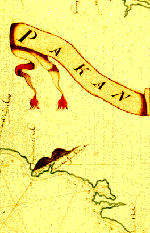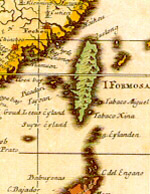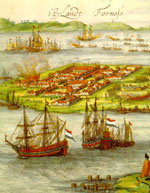Taiwan's 400 years of history
Important milestones from the early 1600s to the
present
Pré - 1600s
Originally, Taiwan was settled by people of Malay-Polynesian
descent, who initially inhabited the low-lying coastal plains. They
called their island Pakan. Here is a detail of an old
Dutch navigational map with this name on it. 
During the subsequent settlement by the Dutch and the waves of
settlers from China, the aborigines retreated to the hills and
mountains, and became the "mountain people."
The 17th Century
The island's modern history goes back to around 1544, when the first
Western ship -- from Portugal -- passed by the island, and named it "Ilha
Formosa" (meaning "Beautiful island"). The person who (literally) put it on the map was Jan Huygen van Linschoten, a Dutch navigator, who published a book in 1596, showing it on a map of East and Southeast Asia. That became its name for the next four centuries.  Taiwan
in the Dutch period
Taiwan
in the Dutch period
Interestingly enough, the most comprehensive historical records on
Taiwan go back some 350 years, to the period of the Dutch occupation,
1624-1662. When the Dutch East Indies Company arrived, they found only
the aborigine population on the island: there were no signs of
any administrative structure of the Chinese Imperial Government. Thus,
at that time Taiwan was not "part of China".
As is seen on a map of those days, it is shown in a different color.
On a narrow peninsula on the Southwestern coast of the island, the
Dutch established a fortress named "Zeelandia",
after the Dutch province of Zeeland. The peninsula was called Tayouan,
meaning terrace bay. This later evolved into Taiwan,
and came to be the name for the whole island.  Dutch
ships in the harbor near Zeelandia Dutch
ships in the harbor near Zeelandia
The Dutch brought in Chinese laborers as migrant workers. for the
sugar plantations and rice fields. They usually came for a few years
(without family) and then returned to China. Eventually, more
settled, and married aborigine wives. Thus a new race was born: the
Taiwanese.
In 1662 Dutch were defeated by a Chinese pirate, Cheng Cheng-kung
(Koxinga), a loyalist of the old Ming dynasty, who himself was on the run
from the newly established Ching dynasty. Cheng Cheng-kung himself
died shortly afterwards, his son took over, but in 1683, this last
remnant of the Ming Dynasty was defeated by the Ch'ing troops.
From the 1680s to the 1880s
However, the new Manchu emperors were not eager to extend their rule
over the island. They were "inland" people with little
knowledge of the offshore islands and even less skill at naval
warfare.
In the subsequent years, immigration to the island from the coastal
provinces of China increased, but the people came to flee the wars and
famines on the mainland, and did not come on behalf of the rulers in
Peking.
Taiwan thus remained a loose-lying area for the next 200 years. At
times, the Manchu attempted to extend their control over the unruly
inhabitants, but time and again the islanders fought back. There were
numerous clashes between the local population and officials sent from
China, leading to the well-known saying in those days: "Every three years an
uprising, every five years a rebellion."
The 19th Century
That China hardly had any influence at all in the coastal waters around
Taiwan is apparent from the two following examples: when in the 1870's
Taiwanese pirates captured American, Japanese and French ships passing
the island, these governments protested to Peking, but the Manchu
emperor said: "Taiwan is beyond our territory."
In fact, the French go so upset by the recurring attacks on their
ships and the Chinese inaction, that they sent a navy fleet to the island,
and for nine months in 1884-85, the northern part of Taiwan was French
territory.
It wasn't until 1887, that the Manchu Imperial authorities decided
to declare Taiwan to be a "province" of their Empire: they
wanted to outmaneuver the Japanese, who were expanding their influence
to the South.
The ploy didn't work: in 1895 the Japanese defeated the Manchu's in
the Sino-Japanese War, and in the Treaty
of Shimonoseki, China ceded Taiwan to Japan in
perpetuity (not 99 years, like Hong Kong's New Territories, but in
perpetuity, i.e. forever).
An important conclusion is thus that Taiwan was an occupied part
of Imperial China for only eight years. Not "always", as
the KMT and the Chinese Communists are claiming.
The Formosa Republic
The Taiwanese didn't like the idea of incorporation into Japan, and
on 25 May 1895 -- with the assistance of disenchanted Manchu officials
-- the Formosa Republic, the first independent republic in Asia
was established. Here is the flag of the new nation: 
However, a few days later, on 29 May 1895, a Japanese military force
of over 12,000 soldiers landed in Northern Taiwan, and started to
crush the movement. On 21 October 1895, Japanese imperial troops
entered Tainan, the southern capital of the Taiwan Republic, ending
its short life.
The Japanese Period
The Japanese occupation was harsh, but at least the Japanese were
not corrupt. The educational system was built up to the same level as
in Japan, infrastructure, trains, roads, industry etc. were developed
extensively. An excellent academic work on the Japanese period is Mr.
George Kerr's work on the "Formosan Home Rule Movement."
An interesting anecdote from the 1930s needs to be mentioned here:
At that time the Chinese Communists under Mao Tse-tung were vying for
control over China with Chiang Kai-shek's Nationalists. In an
interview with American reporter Edgar Snow, Chairman Mao said: "...we
will extend them (the Koreans) our enthusiastic help in their struggle
for independence. The same thing applies for Taiwan" (p.
110 in Red Star over China, by Edgar Snow).
The next major event which affected Taiwan's status was WW II:
during the War, in 1943, the Allied Powers held the Cairo Conference,
and on one sleepy afternoon in the hot Cairo sun, they decided to
agree with Chiang Kai-shek's request that Taiwan be "returned to
(Nationalist) China." This text found its way into the Cairo
Declaration, but of course occurred without any
presence or agreement of representatives of the Taiwanese people.
When the War actually ended in 1945, the Allied powers agreed that
Chiang's troops would "temporarily occupy Taiwan, on
behalf of the Allied forces." As we see, this "temporary"
has become rather permanent. Initially, the Taiwanese were glad to get
rid of the Japanese, but soon their joy turned into sorrow and anger:
the newcomers from China turned out to be corrupt, repressive, and
uncivilized.
The tension burst out into the open in the February
28th Incident of 1947, when a small incident in Taipei
led to large-scale demonstrations. The Kuomintang was initially taken
aback, but secretly sent troops from China, which started to
round up and execute a whole generation of leading figures, students,
lawyers, doctors. In all, scholars estimate that up to 28.000 people were killed,
and during the "white terror" of the following years,
thousands more were arrested, imprisoned, tortured, and murdered
by the KMT's highly efficient KGB-machine, the Taiwan Garrison
Command.
The beginning of Martial Law. In 1949,
Chiang Kai-shek lost the war on the mainland, and fled to Taiwan,
where he established the remainder of his regime. For the next four
decades, the people of Taiwan lived under Martial Law, while the KMT
attempted to maintain the fantasy that they ruled all of China, and
would some day "recover" the mainland. The Chinese
mainlanders who came over with Chiang Kai-shek constituted only 15
percent of the population of the island, but were able to maintain
themselves in a position of power over the 85 percent native Taiwanese
through tight control of the political system, police, military,
educational system and media.
In 1951-52 the Allied Powers and Japan formally concluded World War
II by concluding the San Francisco Peace Treaty.
That Treaty is important for Taiwan, because it decided that Japan
gave up sovereignty over Taiwan, but it was not determined who was the
beneficiary: it was concluded that "...the future status
of Taiwan will be decided in accord with the purposes and principles
of the Charter of the United Nations."
The Charter of the UN contains article 1.2 which states that it is a
purpose of the UN "To develop friendly relations among nations
based on respect for the principle of equal rights and
self-determination of peoples..." The formal result of the San
Francisco Peace Treaty is thus that the people of Taiwan
should determine the future status of the island based on the
principle of self-determination. This Treaty is thus the
first, and the last, international treaty of the 20th Century which
deals with the status of Taiwan.
In 1958, the view from the perspective of the native Taiwanese -- or Formosans
as they were referred to at that time -- was eloquently expressed by Mr. Li
Thian-hok, a young student at the University of Minnesota,in
two articles in Foreign Affairs and the New Republic.
During the following 20 years, from 1952 to 1972, the Kuomintang was
able to build up Taiwan economically, thanks to the hard work of the
Taiwanese, and the sound infrastructure built up by the Japanese. But
on the diplomatic front, they lost ground, and in 1971, their
dreamworld of representing all of China fell apart when Nixon and
Kissinger made their "opening" to China.
In 1971, Peking also took over the Kuomintang's seat in the UN as "representative
of China," and the Kuomintang authorities were booted out. Does
Resolution 2758 say anything about Taiwan's status or Taiwan's
representation ? Not at all. Resolution 2758 dealt only
with the question who was representing China in the United Nations,
not with the question of Taiwan's representation, which was and is a
separate issue, to be dealt with as a follow up on the decisions of
the San Francisco Peace Treaty of 1951-52.
The following year, 1972, was the year of the infamous Shanghai
Communiqué between the US and the Chinese authorities
in Peking. According to a 1985 Rand Corporation report written for US
intelligence agencies, the prime US negotiator, Mr. Henry Kissinger,
is reported to have agreed to the text of the Communiqué after
a dinner of maotai and Peking duck. He reportedly exclaimed to his
hosts: "After a dinner of maotai and Peking duck, I'll sign
anything" . This communiqué is the basis for the
present so-called "One China" policy of the Clinton
administration.
What does the communiqué say, and what does it mean ? In the
1972 communiqué the US "acknowledged" the
Chinese position that there is but one China, and that Taiwan is part
of China. Does this wording mean that the US, and other nations using
similar wording, "agree" with the Chinese position ? Of
course not. It merely states that these nations took note of
the Chinese position, but did not give their own position on the
matter. "Acknowledge" means simply "taking
note of" but not necessarily "agreeing" with someones
position.
In any case, these communiqué's between the United States
and China are of little relevance to Taiwan. Firstly, they were simply
statements at the end of a meeting, and were not ratified, either by
the US Congress or by the international community, and thus do not
have the weight of a Treaty. Secondly, most importantly, they
were made without any involvement or representation of the people of
Taiwan, and can thus not have any validity in determining the
future of the island.
Transition towards democracy
The 1971 and 1972 events, and even more the December 1978 United
States switch in recognition from the Kuomintang regime to the Beijing
regime hit hard in Taiwan. At the same time, it gave impetus to the
growth and evolution of the democratic opposition movement in the late
1970s and early 1980s.
The Kaohsiung Incident
of December 1979 galvanized the Taiwanese on the island and overseas
into political action. The tangwai ("outside-the-party")
democratic opposition started to question the KMT's anachronistic
claim to represent all of China, and began to work towards ending the
40-years' old martial law. In September 1986, this
movement culminated in the formation of the
Democratic
Progressive Party (DPP), which then began its
growth into a full-fledged opposition party.
The Martial Law was finally dropped in 1987, but replaced by a less-stringent National Security Law, which continued to restrict freedom on the island until it was abolished in the reforms initiated by President Lee Teng-hui in 1992. President Lee had succeeded Chiang Kai-shek's son Chiang Ching-kuo after the latter's death in January 1988.
However, it wasn't until 1991 that the KMT claim to rule all of China was dropped, and
that aging Nationalist Chinese legislators -- elected on the mainland
in 1947 -- were sent into retirement. Since then the island has made
major strides in the direction of a fully democratic political system,
but the KMT and its "pan-blue" supporters continue to cling to this day to their
outdated claim that "Taiwan is part of China."
Lee gradually started to restructure the anachronistic system brought over by the Kuomintang from China in the late 1940s. He pushed through reforms which abolished the Legislative Yuan and National Assembly seats still held by aging representatives since their election in China in 1947. Thus in 1991-92, Taiwan saw its first direct elections of all legislators. Also in 1991, the KMT claim to rule all of China was dropped, and the government in Taipei only claimed sovereignty over Taiwan and surrounding islands.
Consolidation of democracy
President Lee continued his push for reforms and in 1996, for the first time in history, the Taiwanese were able to directly elect their President. Lee also pushed for the abolishment of the "Taiwan Province" layer of government, as well as of the National Assembly, which eventually ceased to function in 2005.
In the meantime, the DPP gradually gained strength, increasing its share of the vote in successive elections for the Legislative Yuan, and local offices. In 1994, Chen Shui-bian was elected mayor of Taipei, while in Frank Hsieh Chang-ting was elected mayor of Kaohsiung in 1998 and re-elected in 2002.
The transition to democracy culminated in March 2000 in the election of Chen Shui-bian, who won with 39.3% of the vote in a three-way race against KMT candidate Lien Chan and independent candidate James Soong. In March 2004, President Chen consolidated his position with a slightly over 50% victory over a combined ticket of Messrs. Lien and Soong.
Since 2000 the island has made major strides in the direction of a fully democratic political system, but the KMT and its "pan-blue" supporters continue to cling to this day to their outdated claim that "Taiwan is part of China", and obstruct democratic reforms and budgets for necessary items such as the purchase of arms packages from the US.
Quest for international recognition
The transition to democracy also brought about an increasing desire by the people on the island to become a full and equal member of the international community. In the 1970s, Taiwan had been kicked out of most international organizations because the Kuomintang authorities at that time still continued the claim to sovereignty over China.
In the early 1990s, the island was moving towards being an entity in its own right, and a grassroots quest for membership in organizations like the UN and WHO took hold. In 1995, this prompted former President Lee Teng-hui to start an annual campaign to enter the UN. However, this campaign was a quest to re-enter the UN under the outdated "Republic of China" monniker.
It wasn't until President Chen took over, that the campaign specified entry under the name Taiwan. In the early 2007, this campaign was supported by some 72-75% of the population.
In 1997, an annual campaign to enter the World Health Organization was also started. Initially this campaign had the very modest goal of "meaningful participation" and "observer status" in the World Health Assembly. After several rounds of resolutions in the US Congress, this approach received the support of the American Administration.
However, by 2007, little progress had been made, and in April 2007, the DPP Administration announced in Taipei that from now on the campaign would be aiming at full and equal membership in the world health body.
This is the history of Taiwan in a nutshell. Two conclusions: Taiwan does have a history, and Taiwan has never been an integral part of China.
Back to: Taiwan's 400 years
of history
|

